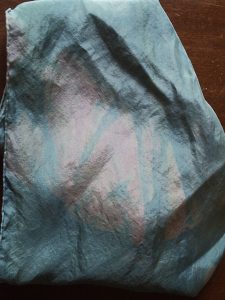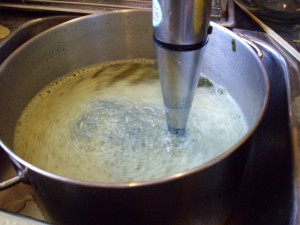The extraction method for indigo is different from that used for other, water soluble, natural dyes. Indigo is insoluble in water. It is necessary to reduce indigo before dying with it. This characteristic of indigo makes dye extraction interesting.
Prepare to (extract) Dye
I use a large stainless steel pot, as my extraction vat. Any heatproof vessel is fine to use. I have dedicated vessels for dyeing, food vessels should be kept separate from dye vessels. I usually fill my extraction vat about half full of water, for a large batch. The water needs to be at boiling when you begin the extraction. You can use your kitchen stove as the heat source. I use an outdoor propane burner, to avoid boiled woad smells in the house.
Due to the unstable nature of indigo precursors, the “indigo” contained in the plant. It is necessary to make your extraction vat acidic, a dollop of vinegar works.
Extract the Dye
Put your extraction vat on to heat, before going to harvest your woad leaves. The main indigo precursor in woad, isatin A, is highly unstable and begins degrading after the leaves are plucked.
Rinse the woad leaves, any dirt can bond with the forming indigo, removing it. This is especially important with small extractions, though not as important with large, 3 kg and up, extractions.
After the vat is boiling, add your woad leaves. It is best to add leaves at a moderate rate, and let them wilt and change colour before adding more.
When all the leaves are added, you can remove the extraction vat from the heat source. Let the vat stand in a sink of cool water. The sink may need frequent refreshing to efficiently cool the vat.
Once the vat is cooled, you can remove the leaves. These used woad leaves can either be composted, or you can use them in a regular natural dye fashion for yellowish colours.
OK, now you have a vat full of indigo precursors. That is nice, but it is not blue yet. There is still one more step on this process.
Forming Indigo: Oxygen, pH, and Time
Converting your vat of indigo precursors to indigo molecules will take another two steps.
Step one: Change the pH of your vat to alkaline. Yes, you heard me right, alkaline. Washing soda works the best, and is not as dangerous as other chemicals. The conversion works best at a pH of ten.
Step two: aerate the vat! Yep, if you have ever dyed with indigo you will know not to add air, as it oxidizes the vat. Well, that is exactly what you want to do now. Oxidize that vat of indigo precursors, then they will form indigo. I prefer a hand-held stick-blender. Using the stick-blender it takes about ten minutes to fully oxidize the vat.
When oxidizing the foam, on top of the vat, will change colours. Initially the foam will start out yellow, then green. After the green forms watch closely, blue will start forming on top of the green, this is good. After the ten minutes the foam usually appears yellow, with blue highlights where the indigo oxidizes on the foam.
After the vat is oxidized, the indigo is stable and will not degrade.
Now What?
Good question, you can either let your newly extracted indigo precipitate out in the vat. Remove the top liquid and figure out a way to dry your pigment. Or, you can reduce the extracted vat, and use like regular indigo. The choice is yours.
Back to You
What techniques have you tried to extract woad, were they successful? Leave a comment.


[…] the indigo, or woad indigo extraction, the molecules which form indigo, known as precursors, are soluble and extracted from the plant. […]